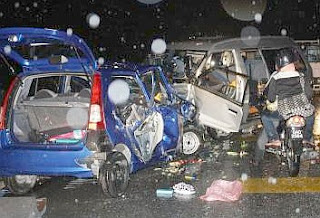Well.. It would have if it was made to go through the crash test but instead, it was given an exemption from compliance by our Ministry of Transport.
On 7 December 2011, the Global New Car Assessment Programme (GNCAP) and the Malaysian Institute of Road Safety Research (MIROS) signed a collaborative MOU to establish a pilot project for an ASEAN
(Association of Southeast Asian Nation) New Car Assessment Program (NCAP). The objective of the program was to
elevate motor vehicle safety standards in the ASEAN region and encourage
a market for safer vehicles. (Source: FIA).
Upon getting the cabinet approval, the Transport Ministry issued a list of
United Nation Economic Council for Europe (UN ECE) regulations for motorcar assemblers and manufacturers in
Malaysia to implement by January 2012. Failing that, the Ministry of
Transport (MOT) had already extended the date by six months
to June 2012. (Source: New Sunday Times, 13 April 2012)
Todate, 10 car-make with 70 model variances listed below still did not meet the regulation under the ASEAN NCAP. Those listed below did not comply and was given an exemption from complying to the UN ECE Regulation 94 and R95. (Source: Road Transport Department (JPJ), website).
The UN ECE Regulation No. 94 and No. 95 specifies a minimum crash safety performance for frontal collision speed of 64 km/h and side collision speed of 64 km/h.
The UN ECE Regulation No. 94 and No. 95 specifies a minimum crash safety performance for frontal collision speed of 64 km/h and side collision speed of 64 km/h.
Notice from the list below, most global carmaker such as TOYOTA, produced two different models of the same car with those in Malaysia not conforming to the Global crashworthiness standard but the same car passed the carshworthiness in other region.
A global car manufacturer has to engineer the car to four different types of national specifications but usually it was designed in compliance to either the US specifications or the General Market specifications. There are also the European specifications and Japan specifications. The US specification is usually the most expensive because of the high safety and environmental specifications.
A global car manufacturer has to engineer the car to four different types of national specifications but usually it was designed in compliance to either the US specifications or the General Market specifications. There are also the European specifications and Japan specifications. The US specification is usually the most expensive because of the high safety and environmental specifications.
 |
| (Source: Road Transport Department (JPJ), website) |
 |
| (Source: Road Transport Department (JPJ), website) |
 |
| (Source: Road Transport Department (JPJ), website) |
From that list, Perodua Viva, that was ranked 3rd highest in overall total units sold, which already has approximately 400,000 cars on the road, sold at the highest, more than 60,000 cars per year with 95% market share in Segment A too was exempted from complying to R94 and R95.
Proton Saga- N Line which was initially exempted too had already been phased out. The new new Proton Saga had scored 3 Star at the recent MIROS crash test assessment.
These exemption given could be one of the reason why Malaysia is no 3 in South East Asia with the highest road fatality per 1,000 registered cars. (Source: NST, 13 April 2013). The forecast for road fatalities too is staggering (See: MIROS Prediction on Malaysian Road Fatalities for Year 2020). Most of our cars on the road, still do not conformed to the crash test standards.
Proton Edar Dealers Association Malaysia (PEDA), urged the Ministry of Transport, Malaysia via its statement issues on 17 February 2013 (Source: PEDA Statement) to withdraw all exemption given to any carmaker that do not comply to the NCAP safety regulation.
Any carmakers, manufacturers or assemblers should not be given any exemption when it involved our safety and fatality.



















Any info about Perodua Aruz
ReplyDeleteRepaired collision damage quickly and cleanly. body shops okc
ReplyDelete